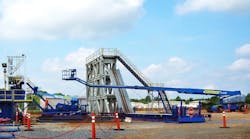The number of unemployed workers with construction experience dropped to the lowest total for August since 2001, as hiring slowed despite robust demand for construction, according to an analysis by the Associated General Contractors of America. Association officials said that the hiring slowdown has more to do with the lack of available workers in many parts of the country than it does low demand.
“The recent slowdown in construction hiring appears to reflect difficulty in finding qualified employees rather than lack of projects needing workers,” said Ken Simonson, AGC chief economist. “The pool of qualified construction workers will need to expand if firms are going to be able to keep pace with rising construction demand.”
Construction employment totaled 6,388,000 in August, the most since February 2009, but the total rose by only 3,000 in August and by an average of only 6,800 per month during the past six months, Simonson said. In the previous six months, construction employed had risen by an average of 29,700 per month, more than four times more. Meanwhile, the number of unemployed workers who reported last working in construction totaled 52,000, the lowest August amount since 2001.
“Hiring has slowed to a crawl in the past six months even though contractors have raised wages at the fastest rate in six years and spending on most types of structures has accelerated,” Simonson said. “Other indicators – such as rising architectural and engineering employment and permits for both single- and multi-family housing – suggest demand for construction will remain strong, but contractors may have difficulty finding enough workers to take on all those projects.”
Average hourly earnings in construction increased 2.8 percent from August 2014 to August 2015, up from 2.1 percent in the previous 12 months, a sign that contractors are raising pay to attract more workers. Employment at architectural and engineering services firms jumped 3 percent since August 2014, suggesting that more workers are being hired to design future construction projects, Simonson noted. Construction spending put in place – a measure of current industry activity – climbed 14 percent from July 2014 to July 2015, the Census Bureau reported on Sept. 1. Permits for new residential construction increased 7.5 percent during that period, the Census Bureau said.
AGC officials urged Congressional leaders to focus on increasing funding for career and technical education programs when they return to Washington after Labor Day. They also called on federal, state and local officials to act on other measures included in AGC’s Workforce Development Plan, designed for recruiting and preparing future construction professionals.









